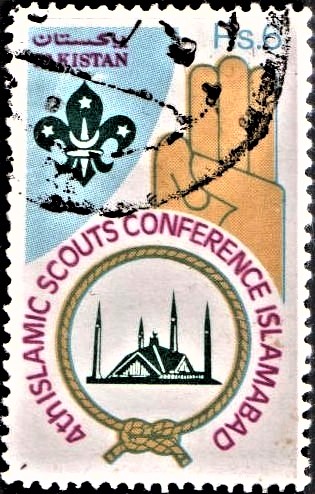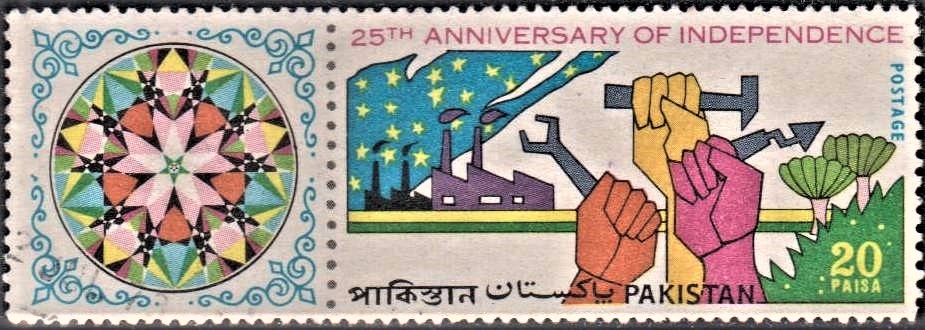
Constitution of Pakistan 1973
A commemorative postage stamp on the Constitution Week 1973 of the Islamic Republic of Pakistan :
 Issued by Pakistan
Issued by Pakistan
Issued on Apr 21, 1973
Issued for : To commemorate the Constitution Week, the Pakistan Post Office is issuing a postage stamp of 20-Paisa denomination on 21st April, 1973.
Design : The stamp is horizontal in format. The National Assembly Building and the Constitution Book form the main subject of the design. The Building which is in brown and black colours appears against light blue sky surrounded by a green border. An open book of the Constitution appears at the top right hand corner of this border in brown and black colours. The caption ‘Constitution Week’ in white appears in the lower portion of the border. The denomination figure ’20-Paisa’ in light blue colour appears in the bottom right corner with the word ‘Postage’ in reverse form. The word “Pakistan” in English and Urdu appears in light blue colour at top and left portion of the border respectively.
Type : Stamp, Postal Used
Denomination : 20 Paisa
Colour : Green, Brown, Blue, and Black
Size of Stamp : 41 x 24.5 m.m.
Size of Print : 38 x 21.5 m.m.
Perforation Gauge : 12½ x 14 (C)
Quantity printed : 7,00,000
Number of stamps in each sheet : 50
Process of Printing : Litho Offset
Printers : The Pakistan Security Printing Corporation Limited, Karachi
About :
- For the first time in the history of Pakistan the National Assembly, elected directly by the people on the basis of adult franchise, met in an historic session on April 14, 1972.
- The Assembly passed a unanimous vote of confidence in the President Mr. Zulfikar Ali Bhutto and adopted the interim Constitution of the Islamic Republic of Pakistan. The Interim Constitution also contained some new provisions necessitated by the attending circumstances. It came into effect from 21st April, 1972, from which date Martial Law was withdrawn.
- The National Assembly also appointed a 25-member Constitution Committee to prepare and submit a draft of the permanent constitution by 1st August, 1972. The Committee held long discussions on the various aspects of the Constitution and agreed on the basic principle that the permanent Constitution should be based on federal and parliamentary system. In order to evolve a consensus on fundamental principles the President met the leaders of the parliamentary parties and groups on 17th October 1972. A Constitutional Accord was signed on 20th October, 1972 between the leaders of the political parties and groups represented in the National Assembly in which basic principles were agreed to by all of them.
- The Committee then resumed its discussions from 2nd December, 1972 and sat continuously till 21st December, 1972 to consider the draft of the Constitution, prepared by the Ministry of Law and Parliamentary Affairs and the National Assembly Secretariat in the light of the Constitutional Accord. The Committee also processed the amendments proposed thereto by its members. The Committee finalised its work on 31st December, 1972 after deliberating for a total of 170 hours in 48 sittings spread over a period of 30 days in all.
- In its deliberations the Committee made every effort to arrive at agreed conclusions and to resolve differences of opinion. There were, however, some minutes of dissent which were appended to the report.
- The members of the Committee took full cognizance of the realities and objective conditions in Pakistan and endeavoured to prepare such a basic law for Pakistan which would not only help create a progressive and egalitarian society but also provide an effective deterrent against exploitation in all forms. The Committee decided to incorporate in the Preamble, with minor adjustments, the resolution passed by the first Constituent Assembly on 12th March, 1949, popularly known as the “Objectives Resolution”, reflecting the struggle waged by the people for a return to democratic and constitutional government and for achieving national unity by creating an egalitarian society through a new order. The Preamble further reaffirmed the Quaid–a–Azam‘s declaration that Pakistan would be a democratic State based on the Islamic principles of Social justice.
- There was complete agreement that the future Constitution of Pakistan should provide for a federal and parliamentary form of government in which the executive would be fully answerable to the parliament – the true embodiment of the will of a sovereign people.
- The draft constitution of the Islamic Republic of Pakistan drawn up in accordance with the Constitutional Accord of 20th October, 1972 and as presented by the Constitution Committee to the National Assembly on 31st December, 1972 in the form of a bill comprises 280 Articles and six Schedules. The discussion in the Assembly continued from about the middle of January to the middle of April, 1973. About 2,000 amendments were moved by various parties. The Assembly completed the second reading of the draft constitution on April 9th and passed the Constitution Bill on 10th April.
- In line with some of the modern constitutions of the world, Pakistan‘s Constitution is a short and precise document leaving a large field to the legislature for enacting organic laws. The Constitution envisages a federal parliamentary system. Although the President will be the constitutional head, the chief executive is the Prime Minister. The Prime Minister will be elected by the National Assembly. Parliament will be bicameral. The National Assembly consisting of 210 members, (including 10 ladies) will be elected on the basis of free, secret and adult franchise. The senate will consist of 63 members, 14 from each province, five from Federally-administered Tribal areas and two from the Federal Capital, elected by the members of the Provincial Assemblies. The Constitution ensures stability by providing that a no-confidence motion against a Prime Minister cannot be moved unless the name of his successor is proposed in the same resolution.
- It guarantees fundamental rights and makes them justiciable. It also lays down Principles of Policy for the guidance of all organs of State making them fully answerable to the National Assembly.
- The division of subjects between the Federation and the Provinces ensures maximum autonomy to the Provinces consistent with national unity and integrity. The federal character of the Constitution is strengthened and made meaningful by the creation of a Council of Common Interests consisting of equal number of representatives from the Provinces and the Federal Government. The functions of the Council include the formulation and regulation of policies in relation to Federal subjects in which the provinces have a vital interest e.g., railways and certain major federally-controlled institutions.
- The Constitution makes provision for the setting up of a National Economic Council to advise the government in the formulation of development plans, and a National Finance Commission for making recommendations for allocating the revenue derived from certain specified sources between the Federation and the Provinces.
- The Constitution declares Islam, for the first time, as the State Religion. It provides for a Council of Islamic Ideology, with enlarged functions to bring the existing laws into conformity with the injunctions of Islam and to recommend ways and means for enabling and encouraging the Muslims of Pakistan to order their lives in accordance with the principles and concepts of Islam as enunciated in the Holy Quran and Sunnah.
- Issued by: The Director General, Pakistan Post Office, Karachi.








[…] April 10, 1973, Z. A. Bhutto gave to the country a unanimously accepted constitution, under which he was to be sworn in as Prime Minister on August 14, […]